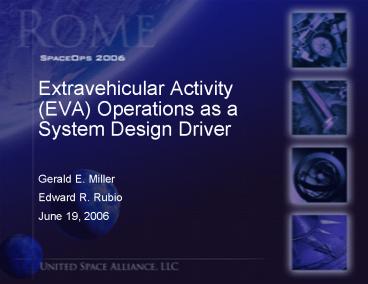Extravehicular Activity EVA Operations as a System Design Driver - PowerPoint PPT Presentation
1 / 18
Title:
Extravehicular Activity EVA Operations as a System Design Driver
Description:
Short-Term Era (2-9 years in the future) Mid-Term era (10-20 years in the future) ... Mid-Term Era Design Drivers. Zero-Prebreathe Suit ... – PowerPoint PPT presentation
Number of Views:70
Avg rating:3.0/5.0
Title: Extravehicular Activity EVA Operations as a System Design Driver
1
Extravehicular Activity (EVA) Operations as a
System Design Driver
- Gerald E. Miller
- Edward R. Rubio
- June 19, 2006
2
There is no reason to send people to the surface
of another celestial body, other than to perform
EVA.
3
Past Programs Approach to EVA
- The impact of EVA has not been a primary
consideration in the design of past space
missions - Apollo came closest to correcting this, but was
limited by lack of experience - EVA was relegated to a secondary consideration in
all subsequent program designs - Skylab
- Mir
- Shuttle
- Shuttle/Mir
- ISS
4
Necessary Approach to Future EVA
- Systems design must be driven by operational
needs and lessons learned - EVA is a major design driver
- Proven fact across years of Soyuz, Gemini,
Apollo, Shuttle, Mir, Shuttle-Mir and ISS EVA
experience - Experience repeatedly demonstrates criticality of
operations-driven design philosophy - Palapa/Westar
- Solar Max
- Intelsat
- Bringing EVA to the forefront of systems design
will be accomplished in stages
- Hubble
- Mir
- ISS Assembly Maintenance
5
Defining the Path from Past to Future
- Short-Term Era (2-9 years in the future)
- Mid-Term era (10-20 years in the future)
- Long-Term Era (20 years in the future)
6
Short-Term Era Design Drivers
- Automated Component Tracking (ground on-orbit)
- Demonstrated ops problem during Skylab, Mir,
Shuttle-Mir and ISS - EVA currently tracks over 500,000 active items
7
Short-Term Era Design Drivers (cont.)
- Spares Management
- EVA items or vehicle ORUs
- Limited life tracking system
- Remote (In-Situ) Training Capability
- Skills-Based Training
- Concept in use, but no technologies explored to
enhance it - Contamination Control (Crew Environment)
- Improved detection technologies
- Decompression Sickness Treatment (Intravehicular)
8
Mid-Term Era Design Drivers
- Zero-Prebreathe Suit
- Significant impact for EVA planning and
operations - EVA responsiveness
- Vehicle impacts
- Avionics
- Crew isolation
- Remote (In-Situ) Consumables Generation
- Significant program impact for supply-chain
logistics - Remote (In-Situ) Repair/Maintenance Capability
- ISS demonstrating impact on overall program
9
Mid-Term Era Design Drivers (cont.)
- Component Interoperability
- EMU/EVA components should be exchangeable with
other systems - i.e., batteries
- EVA/Robotic
- Interaction
- Training
- Current training
- limited to
- SRMS/SSRMS
- interaction
- Future EVA/Robotic interaction more complex
10
Mid-Term Era Design Drivers (cont.)
- Large Field/Cross-Country Terrain Training
- Current experience confined to Shuttle PLB and
zero-g vehicle exteriors (HST, ISS, Mir, etc.) - Develop technologies training for EVA
crewmember navigation, location, transportation,
communication, rescue/retrieval, malfunction
response, etc. in surface terrain - Surface Tracking and Non-Line-of-Sight
Communication - Extraterrestrial surfaces less prone to zero-g
disorientation, but more prone to featureless
navigation - Technologies to overcome communications
obstructions
11
Mid-Term Era Design Drivers (cont.)
- External Overhead Reduction
- Definition of EVA Overhead
- Automated/assisted worksite setup, tools
acquisition, transportation, etc. required - Contamination Control (Suit Components)
- Differs from contamination
- of crew environment
- discussed above
- Apollo 17 crew cites it
- as single, most significant
- issue needing addressed
- for surface EVA
12
Mid-Term Era Design Drivers (cont.)
- Contamination Control (Worksite/Sample)
- Turns normal contamination concerns inside out
- Not dealing with environments impact on suit or
crew, rather EVAs impact on indigenous
environment - Precedence exists with Hubble servicing
- Future examples include water vapor on surface
samples - Smart Return Capability
- Progress in artificial intelligence (AI) required
- Brings EVA/Robotic interaction to bear
- Smart return technology for both nominal and
off-nominal operations
13
Mid-Term Era Design Drivers (cont.)
- In-Suit Medical Treatment
- Currently limited to DCS treatment
- Future needs include
- Triage/diagnosis
- Medication ingestion/injection
- Physical manipulation
- Temporary splinting
- Wound compression
- Overnight Campout Capability
- Accommodates overnight stays at remote worksites
- Addresses consumables transportation, waste
management, shelter provision, etc.
14
Mid-Term Era Design Drivers (cncl.)
- Remote Worksite Power Generation
- Crosses Mid-Range and expands across Long-Range
- EVA on continuous upward trend in task complexity
- Exploration EVAs demand technologies for
- Geological exploration/sampling
- Assembly
- Excavation
- Maintenance
- etc.
15
Long-Term Era Design Drivers
- Virtual Re-Size Capability
- Current technology encumbers mission operations
- Significant impact to supply logistics
- Time consuming when required
- Technology to eliminate Internal Overhead of
resize
16
Long-Term Era Design Drivers (cont.)
- Variable-G Ground Based Training
- Ability to train for EVAs that may occur in
varying gravity conditions - Moon, Mars, asteroids, outer planet moons, zero-g
- Suited Crew Access/Extraction/Retrieval
- Physical challenges of surface EVA
- Crevasse traversing/ bridging
- Inclination/slope translation
17
Long-Term Era Design Drivers (cont.)
- Path/Road Clearing or Construction
- Technologies to clear regularly used paths
- Eventual capability to strengthen and maintain
rudimentary roadways
18
Conclusion
- EVA will be central to future human space
programs - It is the only reason to send humans to alien
surfaces - Future EVAs will require new capabilities
- Technologies needed are diverse, requiring
integration over time - Systems designs must enable these capabilities
- Lessons learned prove the operational impacts of
failing to do so - EVA operations must drive future systems designs
- Failure to consider EVA a primary driver leads to
negative programmatic impacts - EVA cannot be relegated to a secondary
consideration































